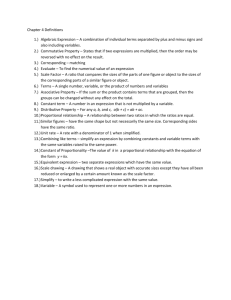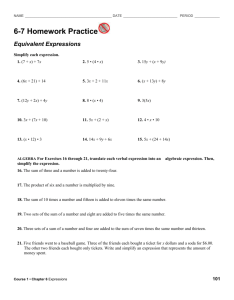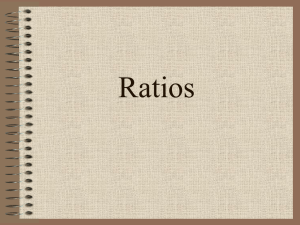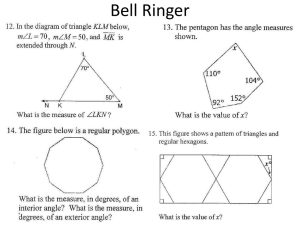Today you will extend your study of ratios by looking at
advertisement
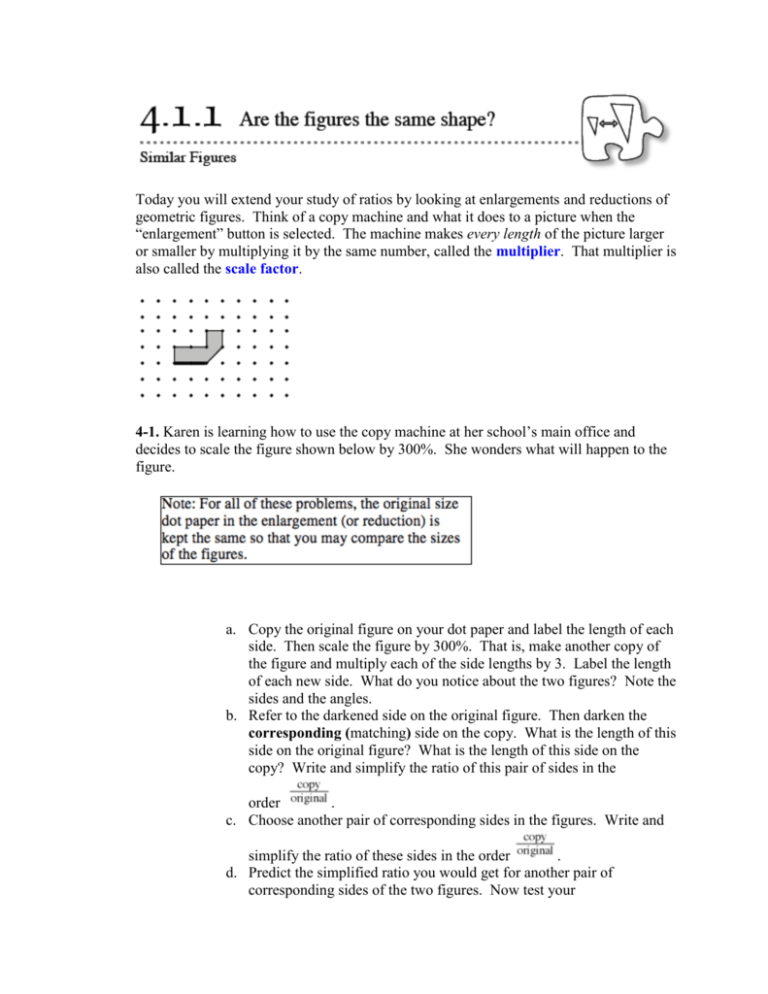
Today you will extend your study of ratios by looking at enlargements and reductions of geometric figures. Think of a copy machine and what it does to a picture when the “enlargement” button is selected. The machine makes every length of the picture larger or smaller by multiplying it by the same number, called the multiplier. That multiplier is also called the scale factor. 4-1. Karen is learning how to use the copy machine at her school’s main office and decides to scale the figure shown below by 300%. She wonders what will happen to the figure. a. Copy the original figure on your dot paper and label the length of each side. Then scale the figure by 300%. That is, make another copy of the figure and multiply each of the side lengths by 3. Label the length of each new side. What do you notice about the two figures? Note the sides and the angles. b. Refer to the darkened side on the original figure. Then darken the corresponding (matching) side on the copy. What is the length of this side on the original figure? What is the length of this side on the copy? Write and simplify the ratio of this pair of sides in the order . c. Choose another pair of corresponding sides in the figures. Write and simplify the ratio of these sides in the order . d. Predict the simplified ratio you would get for another pair of corresponding sides of the two figures. Now test your prediction. Write and simplify the ratio for the remaining pairs of corresponding sides. Was your prediction correct? e. Compare your simplified ratios from parts (b), (c), and (d). What do you notice? How do your answers relate to the scale factor of 300%? 4-2. Karen wants to try scaling the figure shown below by 50%. What do you think will happen to the figure? A. Sketch the figure shown at right and make a copy of the figure scaled by 50% on your dot paper. What is the same about the copy and the original? What is different? B. How is your copy different than the copy you made in problem 4-1? C. Locate at least three pairs of corresponding sides. There are nine in all. Then write and simplify the ratio of each pair of corresponding sides in the order . D. Compare the ratios from each pair of corresponding sides with the scale factor. What do you notice? How do your ratios compare to the scale factor? 4-3. Examine the figure below. A. Use dot paper to sketch the original figure. B. With your team, choose a scale factor the will make the figure larger. Sketch the copy. What was your scale factor? What is the ratio of the corresponding sides? How do the angles compare? C. With your team, choose a scale factor that will make the figure smaller. Sketch the copy. What was your scale factor? What is the ratio of the corresponding sides? How do the angles compare? 4-4. Similar figures are figures that have the same shape but are not necessarily the same size. One characteristic of similar shapes is that ratios of the sides of one figure to the corresponding sides of the other figure are all the same. Another characteristic is that the corresponding angles of the two figures are the same. Patti claims she made a similar copy of each of the original figures shown in parts (a) and (b) below. For each pair of figures, write and simplify the ratios for each pair of corresponding sides in the order . Compare the ratios. Are the figures similar? That is, did Patti really make a copy? 4-5. Additional Challenge: Draw a rectangle on dot or graph paper. Then enlarge the sides of the rectangle using a scale factor of 3. A. Compute the perimeter and area of both the new and enlarged rectangles. B. Write and reduce each of the following ratios: C. How does each ratio compare with the scale factor? Mathematical Properties When two numbers or variables are combined using addition, the order in which they are added does not matter. For example, 7 + 5 = 5 + 7. This fact is known as the Commutative Property of Addition. Likewise, when two numbers are multiplied together, the order in which they are multiplied does not matter. For example, 5 · 10 = 10 · 5. This fact is known as the Commutative Property of Multiplication. These results can be generalized using variables: a + b = b + a and a · b = b · a Note that subtraction and division do not satisfy the Commutative Property, since 7 − 7 ≠ 5 − 7 and 10 ÷ 5 ≠ 5 ÷ 10. When three numbers are added, you usually add the first two of them and then add the third one to that result. However, you could also add the last two together and then add the first one to that result. The Associative Property of Addition tells you that the order in which the numbers are added together does not matter. The answer to the problem (7 + 5) + 9, for example, is the same as 7 + (5 + 9). Likewise, when three numbers are multiplied together, which pair of numbers are multiplied together first does not matter. For example, (5 · (−6)) · 10 is the sames as 5 · (−6 · 10). This is the Associative Property of Multiplication. These results can be generalized using variables: (a + b) + c = a + (b + c) and (a · b) · c = a · (b · c) Note that subtraction and division are not associative, since: and To multiply 8(24), writtern as 8(20 + 4), you can use the generic rectangle model at right. The product is by 8(20) + 8(4). So 8(20 + 4) = 8(20 + 4) = 8(20) + 8(4). This example illustrates the Distributive Property. Symbolically, for any numbers, a, b, and c: a(b + c) = a(b) + a(c).
